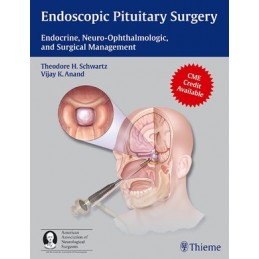- Obniżka


 Dostawa
Dostawa
Wybierz Paczkomat Inpost, Orlen Paczkę, DHL, DPD, Pocztę, email (dla ebooków). Kliknij po więcej
 Płatność
Płatność
Zapłać szybkim przelewem, kartą płatniczą lub za pobraniem. Kliknij po więcej szczegółów
 Zwroty
Zwroty
Jeżeli jesteś konsumentem możesz zwrócić towar w ciągu 14 dni*. Kliknij po więcej szczegółów
A comprehensive guide on current clinical management options for pituitary tumors -- including state-of-the-art endoscopic techniques
Thieme congratulates Theodore H. Schwartz on being chosen by New York magazine for its prestigious ‘Best Doctors 2015 list.
Offering the unique dual perspective of neurosurgeons and otolaryngologists, Endoscopic Pituitary Surgery:: Endocrine, Neuro-Ophthalmologic and Surgical Management describes both cutting-edge endoscopic techniques and tried-and-true decision-making methodologies that lead to the most successful outcomes. From choosing the right surgical or non-surgical approach for individual patients, to managing complex endocrine and neuro-ophthalmologic issues, this is the first major reference in the field in nearly a decade, making it the go-to guide for all interdisciplinary specialists who treat pituitary tumors.
Special Features::
Enhanced by hundreds of images, decision-making algorithms, and clinical pearls from experts on each tumor type, Endoscopic Pituitary Surgery is a comprehensive guide representing the current palette of available treatment options. It is indispensable for residents in training as well as for practicing neurosurgeons and otolaryngologists who are making the transition to the newest minimally invasive endoscopic procedures in the treatment of pituitary lesions.
Opis
1 History of Pituitary Surgery
2 Anatomy of the Pituitary Gland and Parasellar Region
3 Endoscopic Equipment
4 Preoperative Endocrine Evaluation
5 Radiographic Evaluation of Pituitary Tumors
6 Indications for Surgery on Pituitary Tumors: An Endocrinologists Perspective
7 Indications for Surgery on Pituitary Tumors: A Neurosurgeons Perspective
8 Histology of Pituitary Tumors
9 Prolactinomas
10 Acromegaly
11 Cushings Disease
12 Thyroid-Stimulating Hormone Tumors
13 Clinical Management of Nonfunctioning Pituitary Adenomas
14 Neuro-Ophthalmologic Considerations
15 Endoscopic Transsphenoidal Approach to the Sella
16 Clinical Pearls in Endoscopic Pituitary Surgery: A Neurosurgeons Perspective
17 Clinical Pearls in Endoscopic Pituitary Surgery: An Otolaryngologists Perspective
18 Virtual Endoscopy in Endoscopic Pituitary Surgery
19 3D Stereoendoscopic Pituitary Surgery
20 Endoscope-Assisted Transsphenoidal Surgery
21 Endoscopic Pituitary Surgery in the Cavernous Sinus
22 Microscopic versus Endoscopic Transsphenoidal Pituitary Surgery
23 Microscopic and Endoscopic Transsphenoidal Pituitary Surgery: A Reasoned and Balanced Dialectic
24 Extended Endonasal, Endoscopic Transsphenoidal Approach versus Craniotomy for Giant Pituitary Macroadenomas
25 Stereotactic Radiosurgery and Fractionated Radiation for Pituitary Tumors
26 Atypical Adenoma, Pituitary Carcinoma, and the Role of Chemotherapy in the Management of Refractory Pituitary Adenoma
27 The Utility of Intaoperative MRI in Pituitary Surgery
28 Limited Utility of Intraoperative MRI in Endoscopic Pituitary Surgery
29 The Role of Stereotactic Navigation in Endoscopic Pituitary Surgery
30 Anesthesea Considerations
31 Managing Postoperative Sinusitis
32 Managing Carotid Injury During Transsphenoidal Surgery
33 Managing Postoperative CSF Leak
34 Postoperative and Neurocritical Care Management of Patients after Endonasal Endoscopic Transsphenoidal Pituitary Surgery
Indeks: 90245
Autor: Marcelo Fernando DiCarli
A Companion to Braunwald's Heart Disease
